In theory, the buffer flight effect means that a small impact can have the greatest effect. Located in Phom Penh, the capital of Cambodia, the untold truth lies in a historic massacre. A former school, turned into a detention center, is now a museum for guided tours, educating individuals about the devastation of the Cambodian genocide by the Khmer Rouge regime. The S-21 prison was a business and the Killing fields were a place of execution. During this time, an explanation will be given regarding the understanding of the brutality and mass destruction that was experienced. In addition to the personal story of two of the fourteen survivors, who were able to share their story.
History
In the years 1975 to 1979, The Khmer Rouge Regime had begun. This was a short time after the war was over (Details of war). The political group was led by a Marxist dictator named Pol Pot. Pol Pot was responsible for the massacre of his people. In just 4 years alone, it was estimated that he had murdered 1.5 to 2 + million people. All of these deaths were accomplished through disease, torture, starvation, overwork, and execution. The reason behind all his killings is due to the fact that he wanted to maintain an agricultural community (maintain crops and agricultural areas) and not be governed on an equal footing with Western customs. This then divided the country into urban and rural parts, which the division gave rise to in the revolution.
The revolution began with the formation of political parties and recruitment. Propaganda and agitprop were the two main sources used to encourage people to sign up as solidarity. There were about 1,720 soldiers employed between the ages of 15 and 21. Each person employed had been divided into different departments. These departments were categorized as arrests, security, documentation, execution, etc. First, people were arrested for opposing this Khmer Rouge ideology. This triggered resistance movement . The soldiers began by raiding the villages and killing the accused as enemies, until the killing was goalless. The actions of these soldiers became so serious that the killings extended to the point where someone believed to be an intellectual was killed. At one point, even people who wore glasses were killed because they were considered intellectuals.
S-21 prison
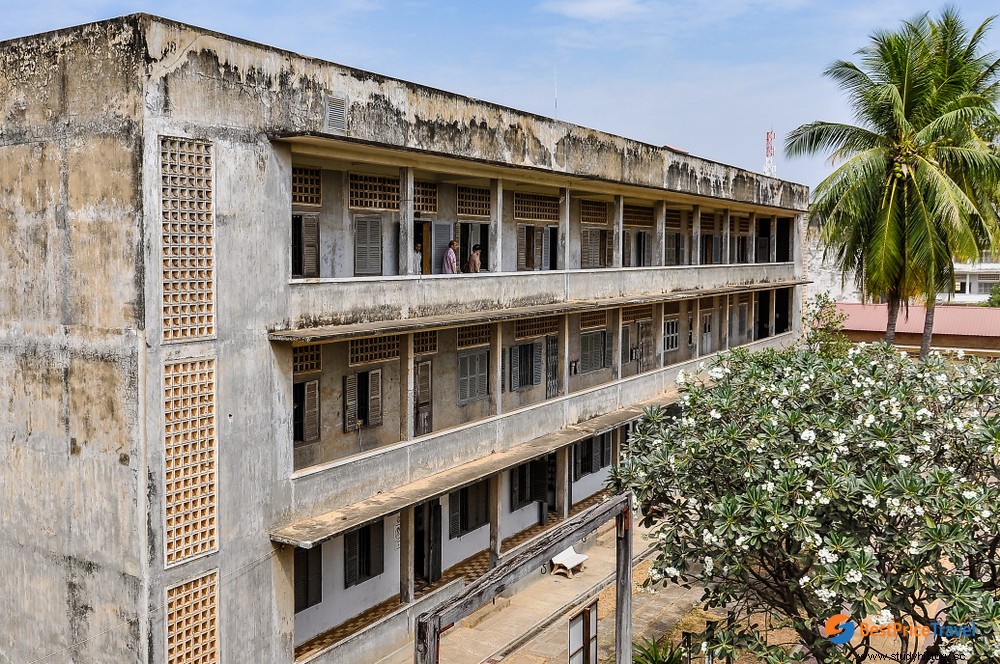
S-21 ( Security 21 ) prison, now referred to as the Tuol-Sleng museum (600x400m²), was a secret for the Khmer Rouge. Before it became a prison, it was a school complex . It had at least 1,600 people. At the end of the regime, it was estimated that the prison housed around 20,000 prisoners. The building was divided into 5 segments, each of which had an assigned purpose. Barbed wire enclosed the balcony to prevent prisoners from escaping or even trying to take their lives. The prison cells were marked in each of the classrooms. Each cell was about 80 cm wide and 2 meters long. There were no bathrooms, which led to waste being excreted in a two-liter bottle (urine) and ammunition cans (feces).
Prisoners' lives
The life of the prisoners was not easy. After being captured and interrogated, they were escorted into cells. Men and women were divorced. The men were placed on the lower levels of the building while the women were on top. None of the prisoners were dressed and each of them was chained. The food they ate was often a spoonful of porridge and a cup of water at times, but they were often starved. The cells were overcrowded, and this led to diseases spreading easily, as hygiene was not considered. Torture and execution were daily occurrences during this time. As for the women, they were raped several times, and if they were impregnated, the child was probably killed. Women were often forced to remain silent. In cases where soldiers were captured, they were also executed. Furthermore, women were also forced into marriage.
http://menengage.org/wp-content/uploads/2014/06/Kasumi_GBV_Study_2007.pdf, elaborates on this topic.
The Killing Field
The killing fields were established as a socio-technical experiment to create a classless society. Anyone who opposed this idea or saw it as a threat was killed. It carries an estimated 20,000 XNUMX mass graves of individuals gathered for execution. Khmer Rouge wanted people to dig their own graves before they were executed. Music was often played to drown out the screams of the people or the noise of the guns during executions.
To save ammunition, they would use wooden clubs, hammers and knives. The proof of this brutality is shown in a large glass house. Remains that were exhumed are all stored here and categorized by tag for how each one had been murdered. The Khmer did not regret anyone, not gender, age, disability, nothing. Their brutality extends to the extreme goal of killing infants in front of their parents. This was done by hitting their heads against killing the tree and then be thrown into the graves with their parents.
Today, the remains are still being discovered. In fact, during a tour, the guide would pour water on the ground and see fragments of bones or clothing. As a tribute to the children, the tourists also wanted to tie bracelets around the 'Killing tree'.
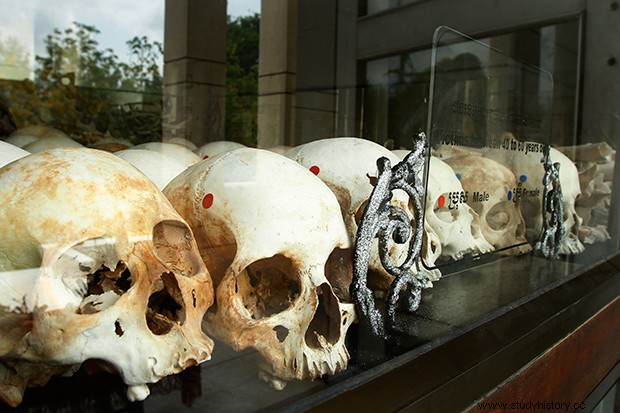
Survivors
After hearing about all the hurtful circumstances that these people went through, 14 people have survived, but only 2 are alive today. The names of the two survivors are Bou Meng and Chum Mey. One story that set me apart was Bou Meng.
In the book published on his behalf, it explained how his story unfolded. His story began when he made a decision to volunteer for the revolution. The goal of the revolution was to liberate the country from slavery and oppression and return power to the former prince (Prince Sihanouk). Unfortunately, this did not work out in his favor.
Bou Meng was 34 when he was captured by the Khem soldiers. The day he was arrested, he was with his wife and thought they would be transported to the assigned place to teach at an art school, but that resulted in captivity. He and his wife were blindfolded and integrated. Bou Meng had indicated that this was the last day he saw his wife. He was then taken to a large room and interrogated. His picture was taken and a bibliography was given during this time.
Bou Meng was accused of working for the CIA, and even when he denied this, his answer was: Angkar has never arrested the wrong person “. He was then taken into custody. At this facility, he, along with several other prisoners, was chained and left in the room. It was estimated that 150 people were placed in this room. They were not allowed to communicate with each other.
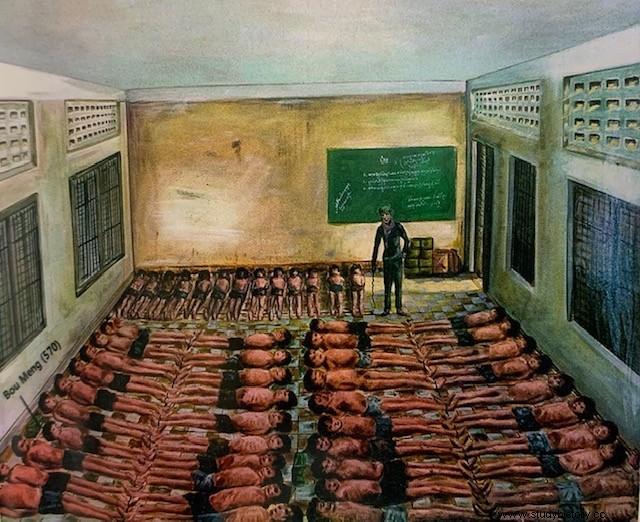
Bou Meng experience
The torture he experienced was far worse than described. He was beaten with various tools such as bamboo sticks, whips, rattan (a type of fiber used for crafts, furniture and as a building material), wagon axles, twisted electric wires and also electric.
One incident in particular that was mentioned was that he was beaten and still forced to carry a guard up several stairs. Salt water was also placed on his healthy wounds after his beating, as they believed that this healed the wounds faster. This was just one of many battles he had encountered as a prisoner of the S-21. Bou Meng added that these actions left him immediately deaf, blurred vision and lost his sense of taste. He slept on the floor without protecting himself from the harsh weather. No pillows, blankets, rugs or clothes were provided.
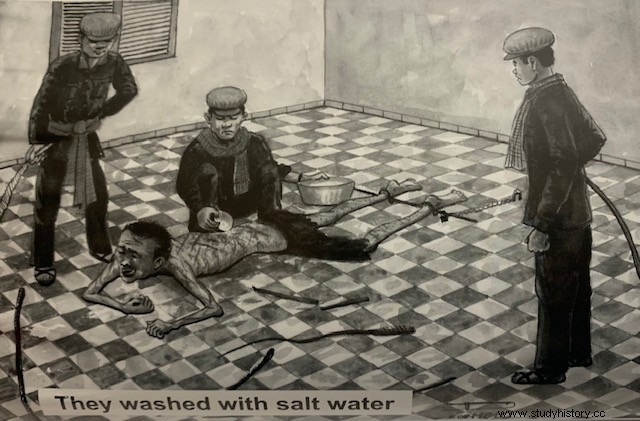
Better days
On the brighter side of the fight that Bou Meng had to live with, he had a talent that saved him. Before he was captured, Bou Meng had a small shop from which he sold paintings. When he joined the revolution, he was assigned to paint pictures or logos for them. A few months after they were captured, the guards searched for someone to paint portraits of Pol Pot. In fact, Bou Meng never met the man himself, but had made a portrait by replicating a picture given to him. He was tested and threatened. They had told him they would kill him if it was not realistic.
Because of his skill, he was treated less harshly. Clothes and shoes made of car tires were given to him. Apart from this, Bou Meng was still locked in a room with the windows closed while he did his job.
He had made a set of friends during this time, each with similar or similar skills as he had. After completing the portrait of Pol Pot, it was compared to the original, and because they could not tell the difference, he was able to look through another day.
Despite the very mildness, Bou Meng still had a deep-rooted fear of the guards and was daily reminded of the punishment he was subjected to. Although it was not his own pain, he saw and heard the pain of others.
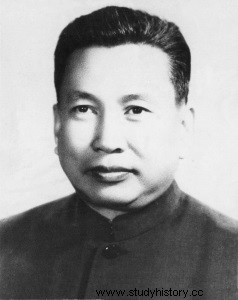
Escape
Things had begun to fall apart for the regime when the guards also began to be executed. Bou Meng had mentioned that the revolutionaries were taught to distrust each other. This was done during training and propaganda, as well as strong criticism.
January 7, 1979, was the day Bou Meng's fight ended. That day, he and a number of other surviving prisoners were told to line up outside. They were escorted to a 'safe' house and locked up. A few hours later, a new set of guards arrived to escort the prisoners when the previous set was executed by their enemies.
Miraculously, as they traveled through rice fields and forestry, they were careful to avoid villages and highways. It was the sound of armored tanks, of the Vietnamese volunteer army as well as the national salvation of Kampucheas that grew. This triggered fear among the guards who escorted the prisoners, and they fled. By this opportunity, Bou Meng and the prisoners had also fled.
Today, both sites are tourist attractions. One as a memorial and the other as a museum. Yet both used to spread awareness and share an understanding of the pain that the country has survived. The photographs of each prisoner are displayed on the walls of the Tuol-Sleng Museum. Bou Meng and Chum Mey also work at the museum and share their stories.
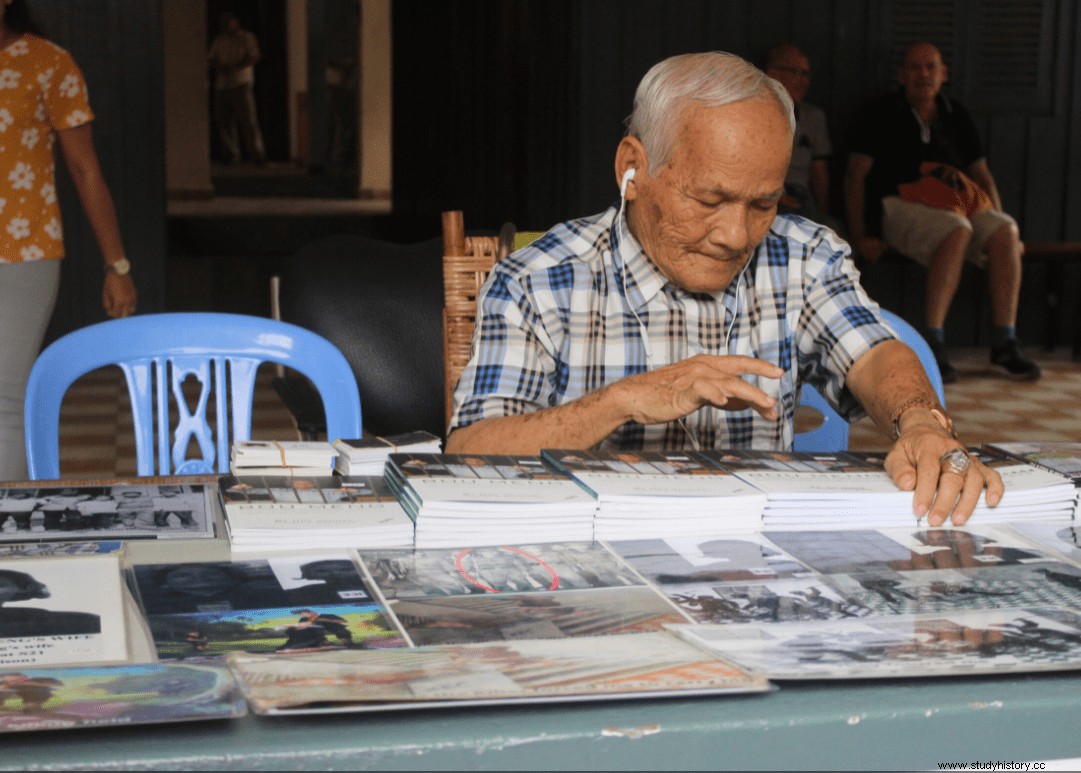
Psychology
As mentioned above, the Khmer Rouge made use of Social Engineering. Social Engineering is a manipulation technique used to obtain information. This technique is still used today, but is more related to cybercrime. Moreover, in terms of propaganda, it had the greatest effect on the people. Psychologically, propaganda is a source of conditioning that uses images and formulations to change behavior. As proof of this, Bou Meng had mentioned this behavior when he first volunteered for the revolution.
Furthermore, from what was collected, PSTD was one of the biggest markings that has affected humans. It has been identified that triggers can be easily associated with the color red . This is due to the fact that Rouge means red . This does not mean that everyone is affected by this, but it is a trigger.
For a thorough reading of the mental health of the Cambodian people, it is suggested that one read:Cambodia's hidden scars. In summary, the book elaborates on the impact of the regime, the trauma behind the action, the trauma in the courtroom when confronted with those responsible, and the impact on people's mental state in the future.
the conclusion
All in all, the butterfly effect of this regime began with a thought that led to mass murder of humans.
There are quite a few questions about the Khmer soldiers that have been raised. To answer a few, a handful of soldiers were captured, 8 to be exact. More information about the trial can be found at https://en.wikipedia.org/wiki/Khmer_Rouge_Tribunal. Some of the former Khmer soldiers were arrested, set on fire, shot, beaten and even taken their own lives. However, some had died of natural causes before the trial took place. Pol Pot also died at the age of 72 due to heart failure. In most cases, the political leaders saw themselves alive. Their identity and whereabouts are not known today. How have their lives been affected for those who live? Do they have any regrets? How many of them are alive?
According to Bou Meng, he specified that he had long sought revenge on the men who had taken his family from him. It was the day of the trial that he had finally received clarity in the death of his wife and children. But he now chooses to move on, although he emphasizes that this can not be forgotten.
Today, the country is striving to grow from the pain they have experienced, and although it is history, there are better days ahead of everyone.
Image credit:https://americansuburbx.com/
